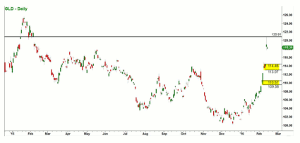In this article, options instructor Russ Allen of Online Trading Academy illustrates how using options gives traders at least two different ways to attempt to acquire GLD at a desired price point below the current price.
After languishing in a downtrend for almost five years, the price of gold has shown some strong signs of life in the last few weeks. On February 12, it settled at a price that was over 17% higher than at the beginning of 2016.
Here is the chart of GLD, the exchange-traded fund that tracks the price of gold, as of February 12:
If we believed that gold was likely to continue the new uptrend that it appears to have started, we would want to find a good entry point to buy. Buying now at the current elevated price would not be a good idea; we would expect pullbacks after such a strong move up. There seems to be a good level at the origin of the latest leg of the up move—at around $110—and another at around $114.
We could just enter a limit order to buy GLD at $110, or $114, depending on how aggressive we wanted to be. But GLD may never pull back to those levels after all, and if not, we would be left standing at the altar. Meanwhile, our funds would be tied up, waiting for our order to be filled.
Using options gives us at least two different ways to attempt to acquire GLD at a desired price point below the current price.
The first of those two ways is to sell an out-of-the-money put option, say at the $114 strike. Out of the money means that the strike price of the put is below the current price (which was $118.36 at the time of this writing).
The March 114 put, with 35 days to run, could be sold for $1.40 per share ($140 per 100-share contract). Selling the put would place $140 in our brokerage account immediately. In return, we would be contractually obligated to buy 100 GLD shares at $114 per share if the option were exercised. We would need to have $11,400 in cash in our account on reserve in case that happened. If (and only if) GLD closed below $114 on the expiration on March 18, then the option would be exercised and the shares would be ours. Our net cost per share would then be $114, minus the $1.40 per share we had received for the puts, a net of $112.60.
The advantage of selling the puts rather than just putting in a limit order to buy the GLD shares at $114 is two-fold: first, our net cost is lower than $114, because we received $1.40 per share for the put. Our cost is reduced by that amount. Secondly, even if GLD never did drop down to our $114 buy point, with the put option we would make money anyway, we get to keep the $140 that we received for selling the put.
To read the entire article, click here…
By Russ Allen, Instructor, Online Trading Academy






















